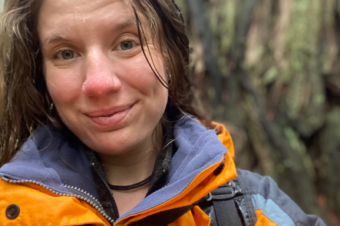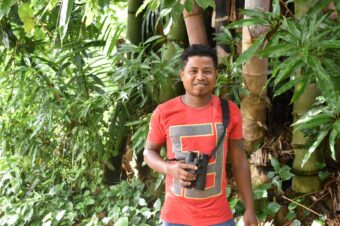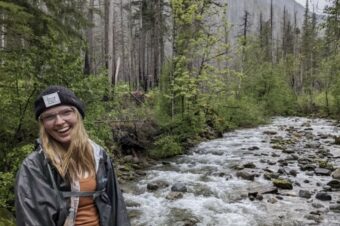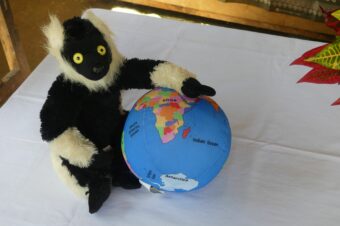Blog from MBP Volunteer, Annie
Along with tracking specific animals in two forest fragments, we are also trying to get a sense of the lemur population density of all the fragments in the area. So, we are now doing transect surveys, where we walk along pre-measured lines and record any lemurs that we see.
Starting out the surveys was a bit of a trick, because the lines do not follow set trails. Instead, they run on a compass heading so that they are all parallel and spread throughout the fragment. This means that not only did we have to find the transect to begin with (the start and end of each 500m line had been previously marked with a GPS) but we also had to use a compass to find each subsequent flagged marker. They were only spaced out every 25 meters, which is pretty close together, but we were typically traversing valleys and steep ridges full of vegetation, so it was really hard to find the flags. Once we learned the paths, though, we could devote our time to walking quietly and looking for any sign of lemurs, either visual or auditory (the group alarms of the Varecias can be heard at great distances).



Once an animal is seen, the guides have to quickly take a few measurements. We record the time the animal was spotted, the number of individuals seen, the distance between the farthest members of the group (also called the “group spread”), the animals’ sex (which you can’t tell easily for Varecia and the Bamboo lemurs, but you can for the Rufis and Rubris), the animals’ distance from the transect line, and the compass bearing for the direction off the line. The distances and bearings are used to estimate the distribution and population densities of the lemur populations based on how often you see them on transect lines and how far away they are. We also record the lemurs’ behavior and the tree species they are using, taking GPS points and estimating the tree height, fruit abundance, and trunk diameter.
Walking the surveys is an interesting change from following lemurs, especially since we sometimes walk surveys in new areas that our animals don’t visit and can catch some spectacular views of the mountainsides nearby.
Because we’re not dashing around trying to keep up with jumping lemurs, we can appreciate all aspects of the forest, from gigantic trees and vines, to rocks and colorful mushrooms (orange, white, pink, and even lavender). There are also the funny fart plants to notice (I don’t know what they look like, but I know there are distinct patches of forest that smell like some herbivore has just let one go, and it can’t be a zebu every time) and strange spiky tree trunks to avoid.
You might also see cool creatures on the way, like a big gecko sunning itself on a Ravenala tree. On a recent transect the guides pointed to the side of a muddy bank to show me a beautiful night jar, perfectly camouflaged to sleep the day away.
And, of course, we also see lemurs, though not as often or consistently as when we’re following them. It makes me appreciate having radio collars on all of our animals, as it would be pretty tricky trying to find them in the forest without those beacons advertising their location all the time, and I have a lot of
respect for the teams that must do just that when they need to locate new animals. At least on surveys we are not looking for a specific lemur species or individual, just whatever we can find!










Leave a Reply